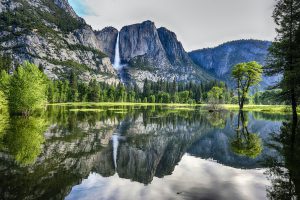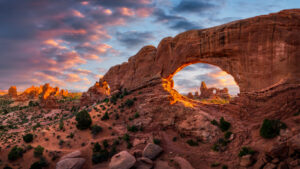What we enjoy the most about RV living is the chance to travel the country. There are amazing things to see and do in every state. Taking an RV camping trip across America is an incredible experience.
One of the best ways to enjoy this beautiful country is by visiting its extraordinary national parks. You’ll be treated to spectacular scenery and endless ways to enjoy nature.
Before you set out on any RV camping excursion, you need to plan ahead. National parks require a different type of planning than private RV resorts or campgrounds. Here are some tips and hints for your RV adventure to America’s national parks.
Map a Route
If you’re traveling across the country visiting national parks, plan your itinerary carefully. You want to visit when the weather is good! Some parks close during the off-season due to inaccessibility caused by winter weather.
Visit northern parks during the spring, summer, or fall. Head for warm-weather southern locations in the winter. Make a route that fits both your needs and the realities of national park popularity and weather conditions.
Pro Tip: If you visit slightly outside of the main season you may have a quieter, more peaceful experience. National parks are busy during peak times and you’re unlikely to find a lot of solitude.
Reservations
Some national parks reserve their campsites far in advance. Yosemite, for example, opens reservations five months in advance.
While most national parks have some first-come-first-served areas, you need to be up and in line very early to get one during busy seasons.
RV camping is almost always restricted to certain sections, and spaces may be limited. Take this into consideration when you plan your itinerary.
Pro Tip: Make a spreadsheet of all the parks you want to visit and when they open reservations. Reserve your site on the first available day for the best chance of getting an RV spot.
Plan Your Visit
Not only should you reserve your campsite, but you should also plan what you want to do while you’re in the parks. Trails, landmarks, and particular sites may all be on your agenda.
National parks are big places. You may not be able to get to the sites you want to see in a motorhome. If you don’t have a tow vehicle, check and see if there are shuttles or other transportation to popular attractions.
Pro Tip: Don’t over-schedule. Leave time for relaxing and low-key exploring. It’s tempting to try and see everything. Prioritize to keep your visit fun instead of stressful.
Pack Wisely
If you’re touring more than one national park, be sure to have the clothing you need for the changes in climate. Even if you’re only going to one park, you may find that the weather varies considerably.
Some parks are very warm during the day and quite cold at night. Others have elevation changes that mean temperature changes.
Also keep in mind that if you’re RV camping in the parks, there will probably not be easily accessible laundry facilities. Bring enough clothing to get you through your visit to each park.
Pro Tip: Bring a swimsuit! And don’t forget water shoes. Taking a dip in a stunning lake in a national park may be the highlight of your entire trip.
National Park Service Campsites
The United States has over 400 national parks, but not all are suited to RV camping. Geography and infrastructure are the two big roadblocks to staying inside the park. Some parks have great RV accommodations, while others have none at all.
For example, Yellowstone National Park has 12 campgrounds with a whopping total of over 2000 campsites. About 1,700 of those are reservation-only. The rest are first-come-first-served.
That sounds like plenty of space. But Yellowstone is one of the country’s most popular national parks. Reserved spaces fill up fast. And not all sites are suitable for an RV.
Most RV camping spots in Yellowstone are limited to vehicles 30 feet in length or less. Some have width restrictions. Most are back-in only. Only one recently renovated campground offers full hook-up pull-through sites.
This patchwork approach is fairly typical inside the parks. Remember that national parks are devoted to the preservation of the land they inhabit. Running full hook-ups is inconsistent with their mission in some areas.
RV camping inside a national park will come with fewer conveniences than other campgrounds. Location may leave campers without good cell signals or Wi-Fi.
Pro Tip: Always check the website for the national park you intend to visit. Because the geography and infrastructure of the parks vary so greatly, you may not be able to RV camp inside your chosen park. But don’t despair! You have other options.
RV Camping Outside the Park
We understand, when you go to a national park you want to be in the heart of its beauty. But private RV resorts and campgrounds right outside the park may have more amenities.
Check the area around your planned parks and look for campgrounds that offer full hook-ups, laundry, shopping, and other things you won’t find inside the park.
For some of you, that would ruin the experience. For others, the whole point of RV camping is to make the most of what your vehicle has to offer. Some RVs are too large for in-park camping.
The biggest downside for those of you with motorhomes is that you will probably need a tow vehicle. But check with the available campgrounds and ask about tours into the parks and shuttle services.
Pro Tip: If you’re visiting smaller national parks, consider traveling in by bicycle. Eco-friendly and fun, cycling can be a great way to explore a beautiful natural area. You may even be able to access areas unavailable to motorized vehicles.
Consider Smaller Parks
Enjoying America’s national parks does not mean you must visit the Grand Canyon. Many of you have seen these sites in the past. How about trying some of the smaller, lesser-known parks?
All national parks are beautiful. Those a little bit off the radar may be less crowded. They may also offer amazing surprises.
Take a scenic train ride in Ohio’s Cuyahoga Valley National Park. Check out the remarkable scenery on a hike through California’s Pinnacles National Park. Experience the incredible ecosystem in South Carolina’s Congaree National Park.
Pro Tip: Smaller parks likely have fewer amenities. Look for offsite RV camping and make day trips into the parks.
Maintain Your RV
RV camping in national parks will put your vehicle to the test. Uneven surfaces, rugged terrain, low-hanging branches, and more will be a challenge. Before you set out on your road trip, bring your RV in for a thorough inspection and service.
The last thing you need is a breakdown deep inside a park with few services. Call or contact us at Leisure Coachworks to get your rig set for the amazing adventures of RV camping in America’s national parks.


